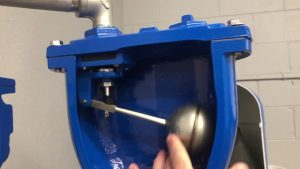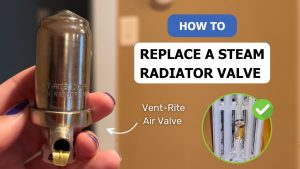What is DBB Valve?
There are two entities in the United States that define DBB—API and OSHA. According to API, a DBB valve is a “single valve with two seating surfaces that, in the closed position, provides a seal against pressure from both ends of the valve, with a means of venting/bleeding the cavity between the seating surfaces.” API also notes in this definition that this valve does not provide positive double isolation when only one side is under pressure.
In contrast, OSHA describes DBB as “the closure of a line, duct, or pipe by closing and locking or tagging two inline valves and by opening and locking or tagging a drain or vent valve in the line between the two closed valves.”
API’s DBB definition does not achieve the same level of isolation as OSHA’s. API allows DBB valves to be one single valve with two unidirectional seats, while the OSHA standard can only be achieved with two separate valves with a method to bleed pressure in between. There are some valves that utilize a twin-valve design. By combining two valves into one body, a twin-valve design reduces weight and potential leaks paths while meeting the OSHA requirements for double block and bleed.
Valve associations usually choose to follow either API’s or OSHA’s definition, but some have created their own handbook with their own definitions for industry terms. For example, the British Valve and Actuator Association (BVAA) defines DBB as “a manifold that combines one or more isolation valves, usually ball valves, and one or more bleed/vent, usually a needle-style global valve, into one assembly for interface with other components (e.g., pressure measurement transmitters, pressure gauges, and switches).”
How does DBB Valve work?
Two block valves provide isolation from the upstream and downstream flows. A set of gate, ball, needle, or globe valves is normally used as the block valves that are placed back to back. In the center cavity of the two-block valves, a third valve known as the bleed valve is positioned.
The same double block and bleed arrangement can be obtained using three separate valves. But the single unit double block and bleed valve saves huge space, weight, installation time, and cost. Also, from the operation and maintenance viewpoint single unit double block and bleed valves are better as potential leak paths are significantly reduced in single unit. Pressure drop is also minimised.
Features of DBB Valve
By strategically incorporating DBBs into a process system you are increasing system integrity and reducing maintenance times. The key benefits of a DBB valve are:
- Increases safety and quick turnaround of maintenance and repair procedures.
- DBB valves are tightly sealed to prevent any leakages.
- DBB valves are resistant to vibrations, changes in pressure and incorporate anti-static and anti-blowout features.
- There is no need to use brackets to support DBB valves as they are designed as a single unit and can be bolted or screwed to the process pipes.
Differences of DIB and DBB
With a DBB valve, there are usually two unidirectional self-relieving seats. These seats do not rely on an outside mechanism to relieve pressure. In contrast, a DIB valve utilizes one or two bidirectional seats. The valve provides double isolation from pressure at both ends of the valve but cannot relieve body cavity pressure past the seats. DIB valves require an external relief system to relieve pressure buildup.
Both valves can provide isolation in both the upstream and downstream directions, even in high-pressure or high-temperature situations. Isolation is important in cases where leakage through a valve could have major consequences. Once the fluid is isolated, the bleed mechanism can drain the area between the two valves or two seating surfaces. This is important for maintenance and integrity check situations where leakage can be monitored.
What is INTEC Duo Ball Valve?
Especially in increasingly safety-critical applications, valves with a “double block and bleed” function are in demand. This requirement can be met by ball valves with a ball bearing and spring loaded ball seats on both sides (Double Block) and a venting or draining connection (Bleed) in the so-called dead space.
The duoball ball valve has a double block and independent shut-off.
- Compared to standard ball valves, the safety can be increased by a factor of 4.
- The design is based on the integration of two ball valves in one body.
- Like all ball valves of the INTEC series, the Duoball valve is available with floating ball or trunnion mounted ball as well as soft or metal seated execution
- All ball seat systems naturally fulfil the leakage rate A according to EN 12266 and are absolutely gas-tight.
- Due to the double insulation and venting function, every duoball valve is bi-directionally tight.
- In addition, the Duoball valve is also available in the standardised overall length according to EN 588 R1 and, in addition to increasing safety, offers a compact and cost-effective alternative to using several standard fittings.
INTEC Duoball valves and CO2 gas (carbon dioxide gas).
For industrial companies, there is a requirement to meet the climate targets, to isolate, transport, safely store or further process of the CO2 gas (carbon dioxide gas) that has been produced.
The CO2 capture and storage are called Carbon Capture and Storage (CCS) and the utilization is called Carbon Capture and Utilization (CCU). For this purpose, the Duoball ball valves type nominal size DN32 with a ball valve as a bleed used to relieve the pressure of the defined smallest possible gap of the double and independent shut-off in the port.
This generates a significant contribution to TCO as a result of optimized OPEX and CAPEX.
Related Tags :
Ten articles before and after
Spring closing unit | API approved valve manufacturer
Repair | API approved valve manufacturer
Space-saving installation | API approved valve manufacturer
Realized and lived sustainability | API approved valve manufacturer
tert-Butylamine (tBA) | API approved valve manufacturer
Diol plant | API approved valve manufacturer
Polymer melt | API approved valve manufacturer
High-pressure Ball Valves | API approved valve manufacturer












